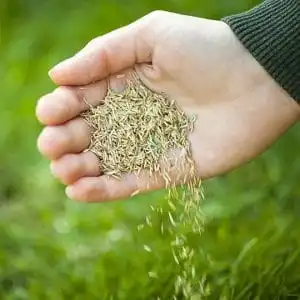Winter is on its way out. As the snow and ice melt away, your lawn may be left in lackluster condition. The colder season is tough on your turf, but adding more grass seed to a lawn can breath new life into your landscaping and repair winter damage. However, when it comes to proper seeding practices, timing is everything. You may be wondering if you should seed the lawn in spring?
Winter Wear and Tear on Your Turf
Your lawn experiences a great deal of wear and tear during the winter months. After the snow retreats, snow mold and other diseases, brown spots, bare spots, and matted or thinning areas become more apparent. The heavy snow, brutal ice, fluctuating temperatures, salt, and hungry animals and insects of winter all take a toll. But you can bring it back to beautiful by using a technique well known to lawn care specialists–overseeding. Overseeding is the process of adding grass seed to existing turf in order to enhance its color, thickness, and overall health.
Seed the Lawn in Spring
The best time to seed a lawn is usually in the fall, but a weary winter lawn can benefit from spring overseeding. The cooler temperatures of fall and spring prevent the seedlings from drying out, and these two seasons provide enough sun and rain to give cool-weather grasses proper growing conditions. Although seeding in the spring is a little more challenging than in fall, these tips help to achieve the best results.
Setting the Scene for Seeding
If you choose to seed the lawn in spring consider doing so early in the season–the beginning of April is the best time. This lets the lawn get a head start in competing with persistent weeds.
Determine your turf type. Before you take on any seeding project, identify the kind of grass in the existing lawn. A professional can help you with this. Cool weather grasses like bentgrass, bluegrass, ryegrass, tall fescue, and fine fescue typically thrive in areas that temperatures drop below freezing.
Consider spot seeding. For something as small as a few bare patches, spot seeding is a simple solution. First, be certain that the damage is not from insects or rodents, because that is a different problem. Use a rake to get rid of dead grass and loosen up the soil. Then, spread the grass seed over the area. You can use a thin layer of mulch or a seed starter mat to keep the seeds in place in the beginning.
Prepare your turf properly for overseeding. This requires mowing the grass shorter than usual, dethatching, amending the soil if necessary, and possibly aeration.
On-going care. Water regularly to create a moist environment for germination and stimulate root growth. Also, take care to minimize weed growth while the new grass is still vulnerable.
To Seed or Not to Seed
Sometimes a lawn only needs a little tender loving care to get back to a thick lush look. Matted grass can be raked to allow sun and air to better reach it. And fertilizer often helps with the healing process. But what do you do when your turf needs more than TLC, or you just don’t know where to start? Severely damaged lawns in need of major renovation require professional attention. Either way, the advice of an expert never hurts.
Want to green up your grass after the harsh winter months? Start now by calling Free Spray Lawn Care at 419-529-5296 for tips and helpful information to seed the lawn in spring.



Comments (0)
Thanks for your comment!
Thanks for your feedback! Your comments have been successfully submitted! Please note, all comments require admin approval prior to display.
Error submitting comment!
There is a problem with your comment, please see below and try again.